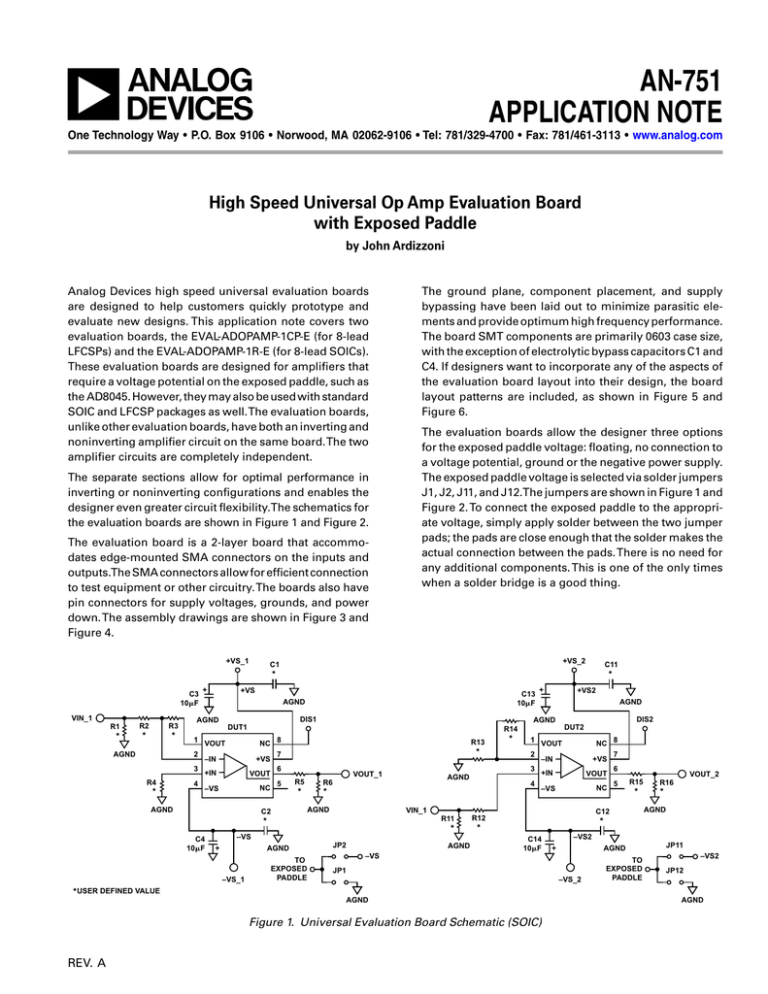
AN-751
APPLICATION NOTE
One Technology Way • P.O. Box 9106 • Norwood, MA 02062-9106 • Tel: 781/329-4700 • Fax: 781/461-3113 • www.analog.com
High Speed Universal Op Amp Evaluation Board
with Exposed Paddle
by John Ardizzoni
Analog Devices high speed universal evaluation boards
are designed to help customers quickly prototype and
evaluate new designs. This application note covers two
evaluation boards, the EVAL-ADOPAMP-1CP-E (for 8-lead
LFCSPs) and the EVAL-ADOPAMP-1R-E (for 8-lead SOICs).
These evaluation boards are designed for amplifiers that
require a voltage potential on the exposed paddle, such as
the AD8045. However, they may also be used with standard
SOIC and LFCSP packages as well. The evaluation boards,
unlike other evaluation boards, have both an inverting and
noninverting amplifier circuit on the same board. The two
amplifier circuits are completely independent.
The separate sections allow for optimal performance in
inverting or noninverting configurations and enables the
designer even greater circuit flexibility.The schematics for
the evaluation boards are shown in Figure 1 and Figure 2.
The evaluation board is a 2-layer board that accommodates edge-mounted SMA connectors on the inputs and
outputs.The SMA connectors allow for efficient connection
to test equipment or other circuitry. The boards also have
pin connectors for supply voltages, grounds, and power
down. The assembly drawings are shown in Figure 3 and
Figure 4.
�����
��
����
�����
��
*
��
*
��
*
����
��
*
�
The ground plane, component placement, and supply
bypassing have been laid out to minimize parasitic elements and provide optimum high frequency performance.
The board SMT components are primarily 0603 case size,
with the exception of electrolytic bypass capacitors C1 and
C4. If designers want to incorporate any of the aspects of
the evaluation board layout into their design, the board
layout patterns are included, as shown in Figure 5 and
Figure 6.
The evaluation boards allow the designer three options
for the exposed paddle voltage: floating, no connection to
a voltage potential, ground or the negative power supply.
The exposed paddle voltage is selected via solder jumpers
J1, J2, J11, and J12.The jumpers are shown in Figure 1 and
Figure 2. To connect the exposed paddle to the appropriate voltage, simply apply solder between the two jumper
pads; the pads are close enough that the solder makes the
actual connection between the pads. There is no need for
any additional components. This is one of the only times
when a solder bridge is a good thing.
�����
���
*
���
���
����
����
����
����
�
��
�
����
�
��
����
���
*
��
����
���
*
�
���
������
��
*
����
��
*
����
����
�����
���
�������
������
����
���
*
����
����
� ����
�
���
�
���
�
���
��
���
����
��
�����
���
*
���
�
����
����
����
� ����
�
���
�
���
�
���
�
����
*
���
����
�
�
�
�
������
���
*
����
*
���
*
���
����
���
*
����
����
�
����
���
���
�����
��
�������
������
����
����
����
*������������������
����
Figure 1. Universal Evaluation Board Schematic (SOIC)
REV. A
����
AN-751
�����
����
��
����
�
�����
���
*
����
���
���
����
����
����
��
*
��
*
��
*
����
� ��
�
���
�
���
�
���
���
��
���
�
�
��
*
�
��
*
�
���
*
*������������������
��
����
� ��
�
���
�
���
�
���
���
����
��
���
�
�
������
���
*
�
���
*
�
����
����
*
�����
���
*
���
�
���
*
����
����
����
��
�������
������
���
*
������
��
*
����
����
����
����
���
���
����
����
�����
�
���
*
����
����
���
�����
���
*
��
�������
������
����
����
���
����� ����
���
�
����
����
�����
����
Figure 2. Universal Evaluation Board Schematic (LFCSP)
COMPONENT SIDE
CIRCUIT SIDE
Figure 3. Board Assembly Drawings (SOIC)
COMPONENT SIDE
CIRCUIT SIDE
Figure 4. Board Assembly Drawings (LFSCP)
–2–
REV. A
AN-751
COMPONENT SIDE
CIRCUIT SIDE
Figure 5. Board Layout Patterns (SOIC)
COMPONENT SIDE
CIRCUIT SIDE
Figure 6. Board Layout Patterns (LFCSP)
REV. A
–3–
AN05142–0–12/05(A)
© 2005 Analog Devices, Inc. All rights reserved. Trademarks and registered trademarks are the property of their respective companies.
–4–


